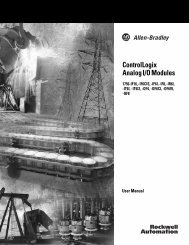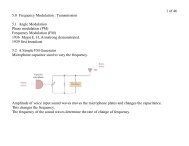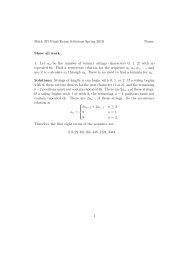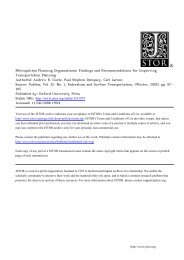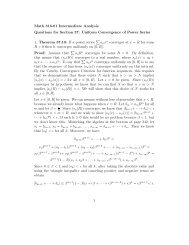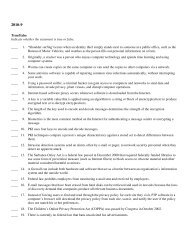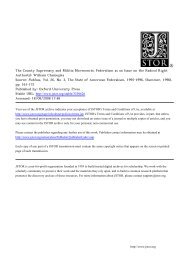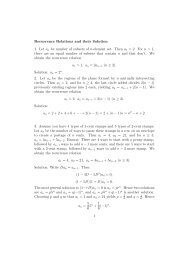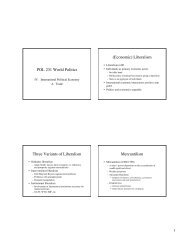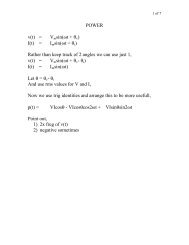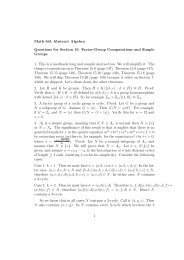Clemons and McBeth - MavDISK
Clemons and McBeth - MavDISK
Clemons and McBeth - MavDISK
You also want an ePaper? Increase the reach of your titles
YUMPU automatically turns print PDFs into web optimized ePapers that Google loves.
42<br />
PARTI . THEORYANDPRACTICE<br />
commonly cited, but not necessarily con-ect, example of the rational model producing poor<br />
policy can be found in the history of U.S. involvement in the conflict we call the Vietnam War.<br />
Secretary of Defense Robert S. McNamara served both Presidents Kennedy <strong>and</strong> Johnson<br />
during the Vietnam War. Vietnam was, in fact, often called McNamara's war. Prior to his<br />
arrival at the Pentagon, McNamara had been the president of Ford Motor Company. He <strong>and</strong><br />
his whiz-kid staff tried to bring with them an approach widely known as systems analysis. This<br />
management approach to organization <strong>and</strong> budgeting was based on statistics, defining clear<br />
objectives, examining long-term cost <strong>and</strong> benefit ratios, <strong>and</strong> systematically monitoring <strong>and</strong><br />
evaluating progress."<br />
McNamara <strong>and</strong> the Pentagon were routinely attacked for an oven-eliance on quantification-<br />
including the infamous use of body counts to prove that our side was winning. Jerome Agel<br />
(1972,76), in an essay indirectly aimed at systems analysis, once took a slap at the legendary<br />
Public Broadcasting System show Sesame Street, arguing that "kids are razzle-dazzled with four<br />
following three-which is exactly what the guys who gave us Vietnam <strong>and</strong> pollution know."<br />
The general critique was that while carefully counting the trees, the managers of our war<br />
effort completely missed the forest. It is not too much to claim that the close association of<br />
the rational model with the can-ying out <strong>and</strong> defense of U.S. policy in Vietnam was enough to<br />
largelydiscreditthis model in the minds of a great manypeople. .<br />
For example, in their history of U.S. foreign policy from 1939 to the mid-1990s, America<br />
Ascendant, Thomas G. Paterson <strong>and</strong> J. Gan-y Clifford (1995) state:<br />
"Management" became one of the catchwords of the time. They had an inordinate faith in data.<br />
When a White House assistant attempted to persuade Secretary of Defense Roben McNamara,<br />
the "whiz kid" from Ford Motor, that the Vietnam venture would fail, McNamara shot back:<br />
"Where is your data? Give me something I can put in the computer. Don't give me your poetry."<br />
Danger lurked in a heavy reliance on quantified information. (p. ISI)<br />
Stanley Kamow (1991), author of the premier text on the Vietnam War writes the following:<br />
McNamara. . . looked at the figures <strong>and</strong> concluded optimistically after only forty-eight<br />
hours in the country that "every quantitative measurement. . . shows that we are winning<br />
the war." No conflict in history was studied in such detail as it was being waged. . . . But<br />
the statistics somehow failed to convey an accurate picture of the problem, much less of-<br />
fer solutions. For the missing element in the "quantitative measurement" that guided<br />
McNamara <strong>and</strong> other U.S. policy makers was the qualitative dimension that could not easily<br />
be recorded. . . . (p. 271)<br />
Approaching the Vietnam challenge like industrial managers. . . . Washington strategists<br />
reckoned that larger investments of men, money <strong>and</strong> material would logically yield larger<br />
results. (p. 284)<br />
And Loren Baritz (1998), author of Backfire (arguing that American exceptionalism <strong>and</strong><br />
;ulture, our technology <strong>and</strong> our bureaucracy, led inexorably to the disaster of Vietnam) almost<br />
~ot it right when discussing the noise, political, <strong>and</strong> bureaucratic problems that affected the<br />
rnalysts <strong>and</strong> blocked rational analysis. But, in the end, he, too, resorts to the familiar critique,<br />
:iting a critic who characterized systems analysis as a model that "discourages the study of one's<br />
)pponents, his language, politics, culture, tactics, <strong>and</strong> leadership." He sums this up with the<br />
-<br />
'The management technique known as "systems analysis" is not to be confused with the idea of political<br />
systems introduced in Chapter I.<br />
t<br />
CHAPTER2 . THE RATIONAL PUBliC POliCY METHOD 43<br />
observation that "By now, this is a familiar point. Systems analysis reinforced the traditional<br />
American assumption that the enemy, or anyone else, is just like us" (p. 248).<br />
Yet we believe that even a shallow reading of McNamara's (1996) own riveting <strong>and</strong> moving<br />
history of the Vietnam War, In Retrospect, makes clear that the problem could not have<br />
been the following of the rational model, because it was not used.7To help you decide whether<br />
it was used or not, we will briefly delineate the rational model. We will then present the minicase,<br />
McNamara's Retrospective: Rational Decision Making?<br />
The Rational Model<br />
The rational model suggests the determination, clarification, weighting, <strong>and</strong> specification of<br />
goals/objectives/values (in other words, of the ends). Next, all plausible, available alternative<br />
means should be listed <strong>and</strong> their likelihood of achieving the ends carefully scrutinized. All relevant<br />
consequences <strong>and</strong> reactions (including side-effects, spillovers, <strong>and</strong> externalities) would be<br />
forecast. Then methods are to be ranked, <strong>and</strong> the most appropriate method <strong>and</strong> implementing<br />
agent(s) chosen, to achieve the most desirable outcome. Decisions should then be made about how<br />
to measure success, gather feedback, <strong>and</strong> evaluate the policy. Review would happen as the policy<br />
environment is scanned, changes noted, <strong>and</strong> adjustments (or even policy termination) occur.<br />
All of this is to happen with analysts operating with stony neutrality, robotlike efficiency,<br />
<strong>and</strong> no politics to taint the expert's choices. In essence, the rational model is about the following:<br />
Gathering sufficientdata <strong>and</strong> expert analysis.<br />
Underst<strong>and</strong>ingthe problem (includingits seriousness,scope, <strong>and</strong> sociopoliticalhistory).<br />
Discerning <strong>and</strong> operationalizing goals with clarity <strong>and</strong> precision so as to make them<br />
achievable<strong>and</strong> prioritized.<br />
Intense <strong>and</strong> thorough thinking so that the ends drive the selection of the means.<br />
Reasoned choicebased on calculation,comparison,<strong>and</strong> cost-benefitratios' so as to maximize<br />
the probability of the effective <strong>and</strong> efficient attainment of the determined objectives.<br />
In addition, the rational model assumes that more information is always better, that the cognitive<br />
limits of our brains are a bad thing, <strong>and</strong> that providing decision makers with more<br />
choices is a good thing.<br />
Figure 2-1 shows a policy decision that hinges on rational analysis. Presumably, an<br />
objective expert would have studied the problem <strong>and</strong> gathered facts to analyze. Goals would<br />
have been carefully thought through, articulated, <strong>and</strong> operationalized so that the costs <strong>and</strong><br />
benefits of the alternative means evaluated are relevant to the desired ends.' In this example,<br />
only two alternatives policies are being weighed, but in the rational model all possible alternatives<br />
are considered. If all of this happens accordingly, theoretically the decisional teetertotter<br />
will tilt toward the policy most likely to produce the optimal outcome. Of course, later<br />
policy evaluation will review how the policy is working <strong>and</strong> begin the process all over again.<br />
The following mini-case quotes exclusively <strong>and</strong> extensively from McNamara's tale. This<br />
verbal. <strong>and</strong> roughly chronological, quote collage will allow you to decide for yourself if the<br />
U.S. pursuit of the Vietnam War was hurt by, or perhaps would have been helped by, use of<br />
the rational model.<br />
'We can, however, criticize the attempt to use it, the resources devoted to trying to use it, the tactical policy<br />
consequences of the attempt, <strong>and</strong> its power as an argument justifying a policy that was arguably not rational.<br />
'Chapter g, "The Positivist Toolbox," has a thorough discussion of cost-benefit analysis (CBA).<br />
'Once again, see Chapter g for a discussion of cost-benefit analyses.





